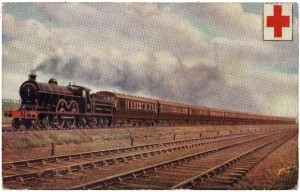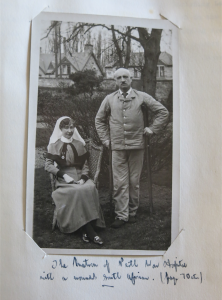Monthly Archives: January 2017
End of January 1917
All material produced or reproduced here and throughout this work is the sole copyright of the author and the family of Doctor D.C.M. Page MC.
As January drew to a close, Douglas is sent for a medical examination of himself!
“I had a Medical Board at the barracks one day. Drs. Kilpatrick and Graham thoroughly overhauled me and discovered that I was anaemic, had a heart murmur and that I was rheumatic! Rot! They granted me a month’s rest. Good! But I never got it”!
Find out about our connection with Dr Page and an introduction to his diary here
6th January 1917 Saturday
All material produced or reproduced here and throughout this work is the sole copyright of the author and the family of Doctor D.C.M. Page MC.
“An ambulance train arrived in Perth Station at 12.30 on the morning of the 6th January. It was a bitterly cold night – freezing hard. The wounded and sick came rolling along to us in ambulance cars and private motors. We admitted 53 cases altogether, and I didn’t get to bed until nearly 5 o’clock. Some of the wounds were very serious, and the men were all very tired.”
Prior to the start of The Great War, Britain had made arrangements to deal with the mass casualties of such an event. Although the concept of the ambulance train owed its origins to the Crimean war of 1854, the main railway companies had been called together and asked to prepare hospital or ambulance trains. Drawings had been sent out for the requirements of such and plans were so well advanced that the first ambulance trains met the hospital ships arriving in Southampton just 20 days after hostilities began.
Men had joined up from all over Great Britain and of course needed to be returned as near to their homes or regimental bases as possible. The trains were made up of everything you would expect to have found in a contemporary hospital. Wards for the casualties, treatment areas and operating theatres. Beds for those that needed them and more casual accommodation for the walking wounded. Accommodation also for the many medical staff on board. Double entrance doors to the carriages to facilitate easy loading. The trains could consist of up to 17 vehicles that could be a third of a mile in length.
Working conditions for medics could be arduous. During difficult times, men with serious injuries by now infected after days of travelling and carrying lice and disease, made life harder for the railway medics than those dealing with it on the front line. Trains could become dirty very quickly working under such pressure. The stench associated with gangrenous infections and trench foot would make the confines stink unbearably. Journey times would be long, progress would be slow as paths for the trains had to be slotted in between regular traffic. Wartime passenger trains, freight trains now heavy with equipment for war, coal trains busier than ever to keep the railways and industry moving, munitions trains and trains full of fresh troops heading for the front to provide more fodder for even more ambulance trains. Long waits for passing prioritised traffic would have been common. It’s not hard to imagine the frustration as progress was halted yet again as the train was reversed into a siding to clear yet another path. Life for the men on the locomotive footplate was hard too with men working extremely long shifts, not knowing when they would arrive or be relieved.
Douglas having experienced life at the front, in the trenches and dressing stations, would be fully aware of what the patients in the Perth War Hospital had gone through. The train that arrived that cold night would have presented him with a scene he was all too familiar with, so was well placed to deal with it, but his understated version of the event almost betrays the chaotic order to which all were subjected to.

Ambulance Train of the Lancashire and Yorkshire Railway https://www.worldwar1postcards.com/ambulance-trains.php
Find out about our connection with Dr Page and an introduction to his diary here
3rd January 1917 Wednesday
All material produced or reproduced here and throughout this work is the sole copyright of the author and the family of Doctor D.C.M. Page MC.
“The Countess of Mansfield and party, including Lady Dewar, gave the men tea and a concert in the hospital on the 3rd January 1917. The tea was a huge success judging from the sounds emanating from the dining hall. The concert afterwards was excellent. Later on the staff had a dance to which we had invited a few of our Perth friends. With the aid of three pounds of boracic powder I got the floor of the dining hall into good condition for dancing. Needless to say the evening was a great success.”
The Countess of Mansfield
This was clearly Lady Margaret Helen Mary Murray (nee MacGregor) Countess of Mansfield, whose home was the nearby Scone Palace. Scone was and is the seat of the Earls of Mansfield.
Lady Margaret Elizabeth Dewar
Referred to by Douglas as Lady Dewar, Lady Margaret Elizabeth Dewar was the wife of the 1st Baron Forteviot, John Dewar, chairman of John Dewar and Sons, the whisky company.
Baron Forteviot had been responsible for the Dewar Report of 1912, which was favouring the introduction of a revolutionary health reform system to try and improve the lot of Scotland’s poor. Maybe this partly explains his wife’s interest in the hospital? On the following day the 4th January 1917 according to The Peerage.com, she became Baroness Forteviot. http://thepeerage.com/p8027.htm
Find out about our connection with Dr Page and an introduction to his diary here
